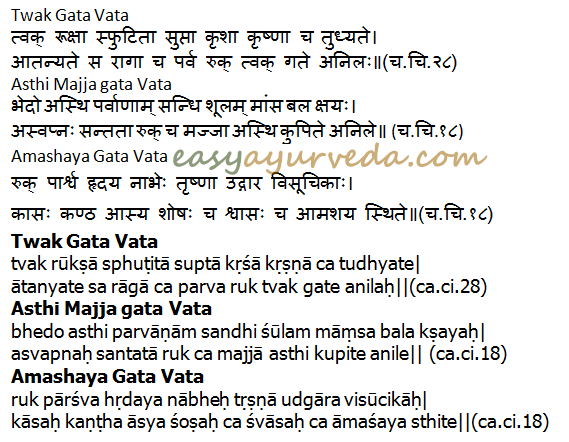Gata Vata: Vitiated Vata Seated In Tissues, Visceral organs
Article by Dr Raghuram Y.S. MD (Ay)
Gata Vata is a pathological condition of Vata wherein the vitiated Vata gets lodged in the tissues and visceral organs, consequently damaging the tissues and organs and giving origin to many diseases.
Table of Contents
Uttana Dhatus
The first 4 tissues in the chronology of tissues i.e.
Rasa dhatu (lymph, plasma or circulating nutrients),
Rakta dhatu (blood tissue),
Mamsa dhatu (muscle tissue) and
Meda dhatu (fat or adipose tissue) are said to be uttana dhatus or superficial tissues.
Gata Vata involving the vitiated Vata getting lodged in these tissues will lead to diseases pertaining to these tissues. These diseases, when not chronic in nature and when multiple tissues are not involved are said to be easily curable.
Read related: How To Observe Vata Dosha Imbalance Symptoms In Your Body By Yourself?
Gambhira Dhatus
The last 3 tissues in the chronology of the tissues i.e.
Asthi dhatu (bone tissue),
Majja dhatu (Bone marrow tissue) and
Shukra dhatu (semen tissue) are said to be gambhira dhatus or deep seated tissues.
These tissues are also considered as Marmas or vital tissues. Gata Vata involving vitiated Vata getting lodged in these tissues will lead to the diseases pertaining to these tissues. These diseases are said to produce serious and life-threatening disorders when afflicted by morbid vata, in comparison to the vitiated vata getting lodged in uttana dhatus.
We need to remember that superficial and deep tissues should not be taken in literary meaning. They are not located one deeper than other anatomically.
Classification is based on chronology in which tissues are formed. In chronology of formation of tissues, lymph is formed first and semen at last. This chronology is explained in Ayurveda texts. This is based on concept that one tissue is formed from other in that order.
From nutritional juices formed in stomach after digestion of food, lymph (rasa tissue) is formed first. From lymph is formed blood tissue. From blood muscle is formed, from muscle is formed fat tissue. Fat tissue leads to formation of bone tissue and from bone tissue bone marrow is formed. From bone marrow tissue semen is formed at last. If previous tissues are not formed properly, later tissues are also not formed properly.

Examples of Gata Vata of Vata –
Twak Gata Vata
Twak gata vata (vitiated vata seated in skin):
When vitiated vata gets lodged in skin, the below mentioned symptoms can be seen –
- Ruksha – dryness of skin
- Sphutita – cracks in skin
- Suptaa – numbness
- Krushaa – emaciation
- Krushna – darkness / blackish discolouration of skin
- Toda – pricking sensation
- Aatanyate – skin seems to be stretched
- Sa raagaa – reddish discolouration of skin
- Parva ruk – pain in inter-phalangeal joints
Asthi Majja Gata Vata
Asthi-Majjagata Vata (vitiated vata seated in bones and bone marrow):
When the vitiated Vata gets seated in bones and bone marrow, the following symptoms are seen –
- Asthi bheda – splitting pain in the bones
- Parva bheda – splitting pain in the inter-phalangeal joints
- Sandhi shula – pain in the joints
- Mamsa kshaya – emaciation of muscles
- Bala kshayaha – deterioration of strength
- Aswapna – sleeplessness
- Santataa ruk – constant pain
Amashayagata Vata
Amashayagata vata (vitiated vata seated in stomach):
When vitiated vata gets lodged in amashaya or stomach, the following symptoms are seen –
- Parshwa ruk – pain in flanks
- Udara ruk – pain in abdomen
- Hrudaya ruk – pain in the region of heart
- Nabhi ruk – pain in the navel region
- Trushna – thirst
- Udgaara – belching
- Visoochika – cholera
- Kasa – cough
- Kantha shosha – dryness of throat
- Asya shosha – dryness of mouth
- Shwaasa – dyspnoea, shortness of breath, breathlessness
Sarvanga Vata
Sarvanga vata (Vata vitiated in entire body) Vata vitiated in entire body causes tremors and shaking in body parts, cracks in joints or splitting pain in joints among many symptoms.
Guda Sthita Vata
Guda sthita vata (vata aggravated in anus and rectum) Vata aggravated in anus and rectum causes dryness, emaciation and pain in legs, sacral region, legs and hands.
Pakwashaya Sthita Vata
Pakwashaya sthita vata (Vitiated vata seated in colon) Pain in sacral region is one of symptoms of vata aggravation in colon.
Mamsa Medagata Vata
Mamsa meda gata vata (Vitiated vat seated in muscle and fat) Presence of throbbing pain in muscles and pain as if beaten with sticks is experienced in vitiated vata afflicting muscles and fat
Snayugata Vata
Snayu gata vata (Vitiated vata seated in ligaments) when vata aggravates in ligaments, it causes twitching, sprains and pain in foot and other joints and diseases afflicting part or whole body, mainly degenerative diseases of joints.
Sandhigata Vata
Sandhi gata vata ( Vitiated vata seated in bones) When vata gets aggravated in joints, it causes destruction and damage to ligaments of joints, pain, swelling and difficulty in movements. This condition is compared to osteoarthritis.
Read related: Yogavahi: How Vata Dosha Interacts With Pitta And Kapha
Note – There are many such conditions explained related to Gata Vata type of pathology, these are few examples for the sake of understanding.
Click to Consult Dr Raghuram Y.S. MD (Ayu)








2 comments
Sai
Which are the foods , fruits and nuts good for Vata balancing…and in general tridosha balancing
Dr J V Hebbar MD(Ayu)Author
Read here
https://www.easyayurveda.com/2010/05/19/ayurveda-vata-diet/